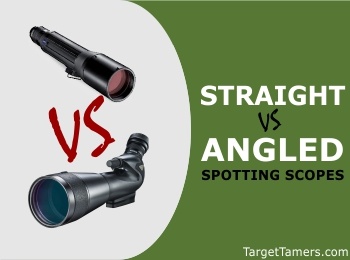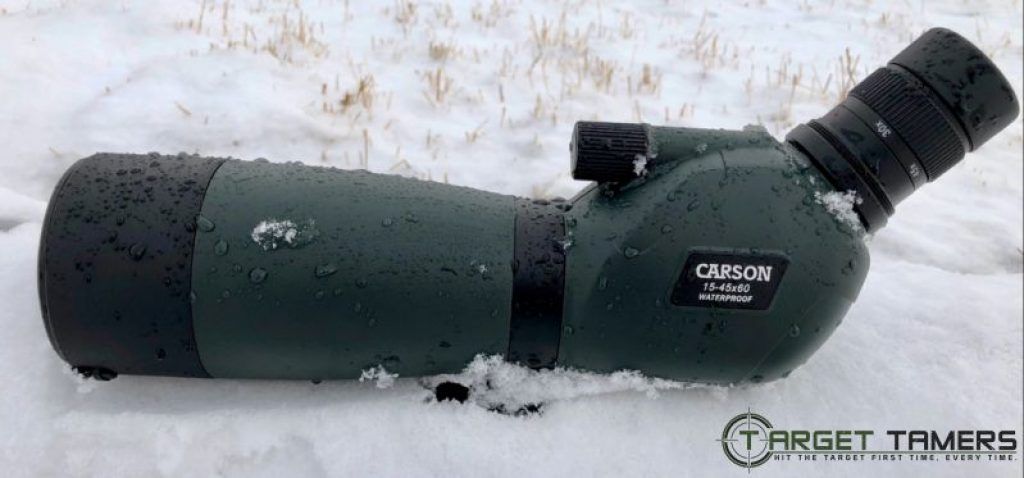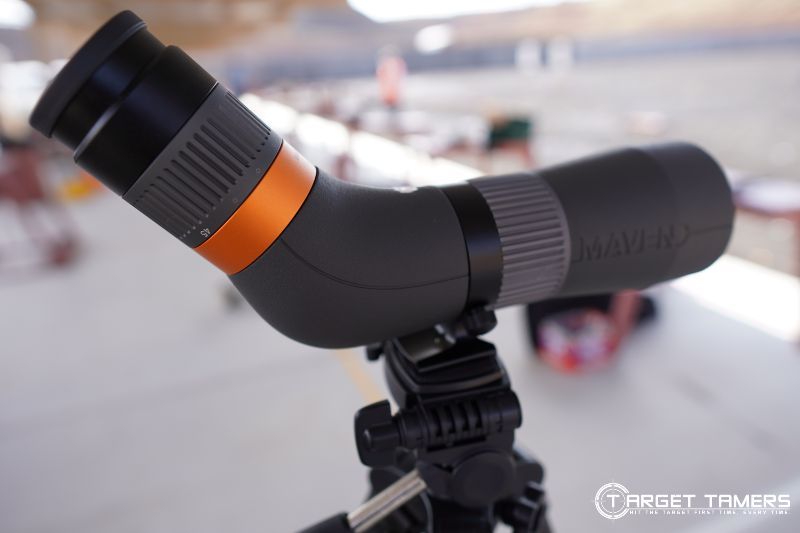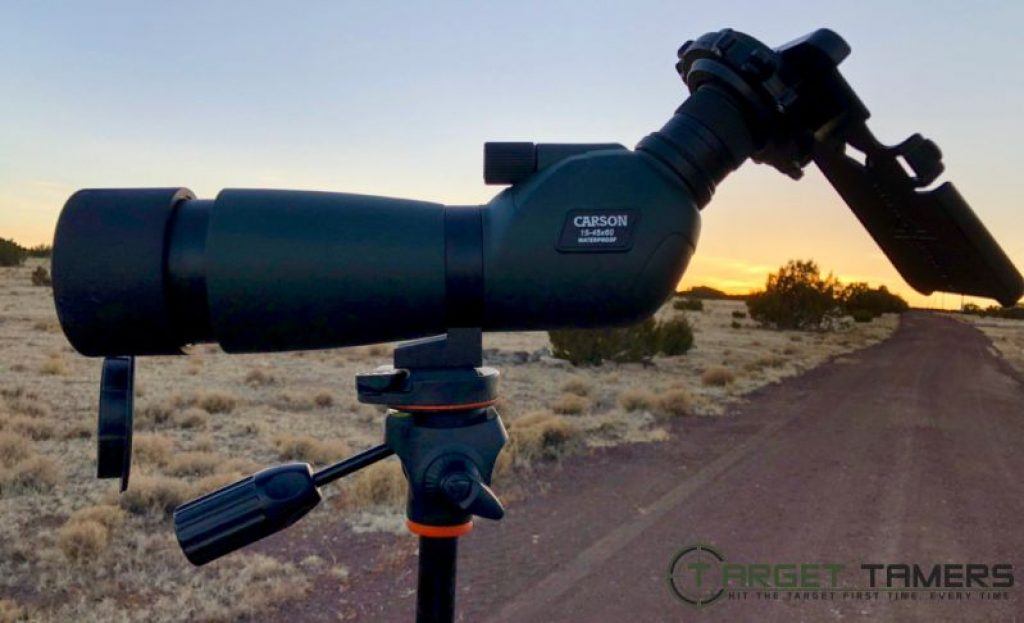
Perhaps one of the least understood scopes in the sports optics market is the spotting scope. And, unfortunately, it's only because hunters don't know how to use it to its maximum potential or they've never really implemented one while out in the field.
Should you buy an angled spotting scope, or a straight one? What type of coatings do you need? And what on earth is digiscoping!?
The best reviews shouldn't just tell you which spotters are the best to buy, they should also fill you in on designs and features to help you decide what scope is right for your style of hunting.
That is our goal here so, I'm proud to say that you can check each item off your list as you pore over the spotting scope reviews and buying guides found on this website.
Straight vs Angled Spotting Scopes
The straight vs angled spotting scope debate is, at its core, a matter of preference. And, this certain feature of a spotting scope will be on the top of the list to consider when you're ready to buy the best spotting scopes. So, let's get into it right here and right now.
Straight Spotting Scopes

Straight spotting scopes have the eyepiece and the body of the scope on the same horizontal optical plane.
Sometimes the eyepiece is in the exact horizontal level as the body of the scope. Sometimes, the eyepiece is at a level higher than the body as with Porro prism spotting scopes, but it still maintains its horizontal optical design.
Who Should Use a Straight Spotting Scope?
All hunters with different skill-levels can easily use a straight spotting scope. But, they're especially user-friendly and intuitive for new users to spotting scopes because it's easier and faster to spot and track moving targets.
When to Use a Straight Spotting Scope?
Hunting and target shooting. They will prove especially convenient if you regularly hunt and shoot from tree stands, blinds, ridge-lines, and from car mounts. And, they could work well for nature-observing and marine-watching.
Benefits of Straight Spotting Scopes:
- Intuitive and easy to use
- Faster than angled at target acquisition
- Forms a straight line from you to your target
- See target in the same direction scope is in
- Don't have to adjust tripod to find target when trading binoculars off tripod and replacing with spotting scope for finer and closer viewing
- Can be mounted higher off the ground to avoid most effects of mirage
- Easier to view at levels below eye-level or yourself
- Easier to move and use when attached to car mount
- Eyepiece has more protection from rain and snow
Drawbacks of Straight Spotting Scopes:
- Need to raise tripod to eye-level, can decrease tripod stability
- Can be uncomfortable to achieve high angles and maintain them
- Less convenient to share with others
Angled Spotting Scopes

Angled spotting scopes usually have the eyepiece at a 45 degree angle to the scope body.
Who Should Use an Angled Spotting Scope?
Angled spotters are a little more difficult to use because your line of sight is now on an angle making it harder to detect moving targets. Typically, hunters that have some experience with spotting scopes will do better with them. But, practice can eliminate this disadvantage.
When to Use an Angled Spotting Scope?
Hunting, birding, and some casual astronomy use. Angled spotting scopes are quite versatile for all-round, general use.
Benefits of Angled Spotting Scopes:
- People of different heights can conveniently use scope without raising or lowering the tripod
- Can be mounted lower on a tripod to be less affected by wind
- Easier and more comfortable to view on angles looking up
- Can rotate on angles to make viewing while on car mount easier
- Easier and more comfortable to use while in a seated or lying down position
Drawbacks of Angled Spotting Scopes:
- Can be more expensive than straight model
- Requires a little more spotting scope experience
- Can have more features that can complicate use
- Eyepiece is more exposed to rain and snow while in use
The Bottom Line on Spotting Scope Body Style Design
Straight spotting scopes will do excellently on the target range and while hunting, especially when looking below your level is critical. They're very easy to use.
Angled spotting scopes will do exceptionally well while birding because of the ability to look higher more comfortably. While they do great for hunting, they might be a little harder to get used to in finding and tracking your target. It will require more practice.
If you really can't decide between either of them, consider a system such as the Swarovski ATX/STX spotting scopes. You could purchase the objective module which is compatible with both an angled and a straight eyepiece.
When you want to bird, switch it out for the angled, and when you want to concentrate on marksmanship at the range, switch back to straight.
Of course, this is the most expensive way to do things and it'll cost you more than just an arm and a leg, perhaps both arms and legs and a kidney too!
Other Spotting Scope Design Features
Being able to narrow down on your choice of spotting scope should always include a little research about the features.
If you want a little more info on the foundational features of a spotting scope that will significantly influence your buying decision, check out our Spotting Scope Buying Guide for the full run-down. There, we'll go over aperture, magnification, and all that good stuff.
But, here in this article, we'll go over some of the custom, more-advanced, and high-end features you'll want to see in a spotting scope to help you optimize your hunt.
1. Dual Focus
Dual focus is often a high-end feature that allows you to get your image even more sharper for viewing those fine details. It's usually found on the same knob as the course or quick focus.
2. Focus Knob or Ring?

Knobs are exposed to damage and snagging while out in rough terrain, but they're the most common focus control found on spotting scopes.
Many focus rings or collars can be stiff to use, but if it's been integrated correctly, they'll be smooth to focus. Some spotting scopes conveniently have the zoom ring located next to the focus ring.
3. Eyepiece Bayonet System
This is a high-end feature that ensures interchangeable eyepieces are securely connected to the body of the spotting scope.
The interlocking system guarantees that the eyepiece can't accidentally fall off or come apart. To disassemble, there will be a release button that needs to be depressed, give the eyepiece a gentle twist, and it's out.
4. Center Locking System
This is a little knob that's located to one side of the spotting scope in the center.
This is the feature that allows the spotting scope to be rotated to various angles and then locked into place. These multi-view angles are usually 45, 90, and 180 degrees.
5. Prism Systems
Spotting scopes use refractor prisms, such as porro and roof, to erect an image that's forward facing and right-reading.
Some spotting scopes may integrate mirrors or use prism-less lens assemblies to create the optical pathway. These systems are often more expensive versus the commonly-used Porro prism.
6. Glass/Lens Coatings
The better quality coatings the spotting scope has, the better the contrast, resolution, and clarity the image will have.
Fully multi-coated optics, water-repellent coatings, and scratch-resistant coatings for hardness will protect your lenses and your vision. The spotter will cost more too.
7. Special Glass
Extra-Low Dispersion, APO, fluoride-containing, and High Definition glass all stems from glass elements and compounds to produce the best image quality possible.
These extra elements will drive the price up more as they significantly drive up quality.
8. Digiscoping

Digiscoping is the ability to use a camera with a spotting scope. They can enable a hunter to catch the memory of his trophy before it became dinner. Photographers and wildlife observers can catch the beauty of a scene with a single snap.
Straight Or Angled? Which Will You Choose?
Ultimately, deciding on the body style of your spotting scope and figuring out what other design features you want comes down to what you will be using the spotting scope for.
Will you mostly be ranging and hunting? A straight scope will benefit you. Is birding your primary glassing activity? Do your neck a favor and go for an angled scope. Wanting to use a camera with your scope? Make sure it is digiscope adaptable.
I think you get the picture!
Ready to Choose? Check Out Our Pick of the Best Spotting Scopes Here
Further Reading
- Wire vs Glass Etched Reticles: Which Should You Choose for Your Rifle Scope?
- What Is Your Best Hunting Gear Investment? 25 Expert Hunters Weigh In
- What is the Sight Picture & Sight Alignment? [WITH PICS]
- What Is The Difference Between Reflex Sights VS Red Dot? Find Out Here!
- What Is MOA? Calculating Minutes of Angle & Making Turret Adjustments



